FANTASTIC PLASTIC & CO.
Plastica et similia: poliuretano, poliestere, nylon, lycra, vinile, sky… A partire dalla metà del secolo scorso una delle grandi sfide della moda, è rappresentata dal ricorso ai materiali che la tecnologia ha saputo inventare o ripensare, affiancandoli o sostituendoli a“quelli di sempre”, quelli che solo Madre Natura può fornire agli umani per coprirsi, scaldarsi ed anche adornarsi. 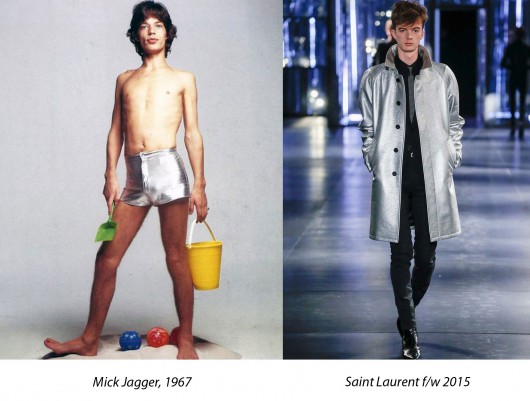 La ridefinizione della materia, acquisisce in meno di un secolo una velocità infinitamente superiore di quella che ha conosciuto nei secoli precedenti. In concreto: in pochi decenni la moda si è ritrovata a disporre di una gamma di materiali incredibilmente più ampia, sfaccettata e stimolante rispetto a quella con cui dovevano cimentarsi i creatori di un tempo, con un vantaggio incommensurabile per la creatività del presente e con un riflesso determinante sul modo attuale di concepire il vestire.
La ridefinizione della materia, acquisisce in meno di un secolo una velocità infinitamente superiore di quella che ha conosciuto nei secoli precedenti. In concreto: in pochi decenni la moda si è ritrovata a disporre di una gamma di materiali incredibilmente più ampia, sfaccettata e stimolante rispetto a quella con cui dovevano cimentarsi i creatori di un tempo, con un vantaggio incommensurabile per la creatività del presente e con un riflesso determinante sul modo attuale di concepire il vestire. 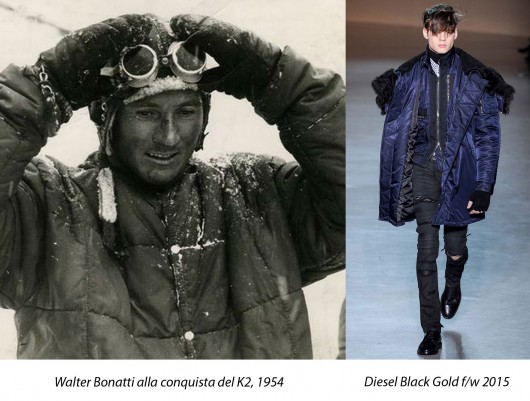 Il processo di innovazione materica applicato all’abbigliamento prende il via quasi sempre dal bisogno di funzionalità. Un bisogno spesso legato ai momenti piacevoli dell’esistenza, come lo sport o le ore passate all’aria aperta. Da un area decisamente avanzata in fatto di tecnologia, quella anglosassone, una parte di mondo contraddistinta da condizioni climatiche abbastanza parche in quanto a sole, giungono non pochi capi divenuti in breve leggendari, caratterizzati dall’uso dei materiali elaborati dall’industria – o meglio, dalla chimica applicata alla produzione industriale – non di rado sommati e accoppiati a quelli naturali.
Il processo di innovazione materica applicato all’abbigliamento prende il via quasi sempre dal bisogno di funzionalità. Un bisogno spesso legato ai momenti piacevoli dell’esistenza, come lo sport o le ore passate all’aria aperta. Da un area decisamente avanzata in fatto di tecnologia, quella anglosassone, una parte di mondo contraddistinta da condizioni climatiche abbastanza parche in quanto a sole, giungono non pochi capi divenuti in breve leggendari, caratterizzati dall’uso dei materiali elaborati dall’industria – o meglio, dalla chimica applicata alla produzione industriale – non di rado sommati e accoppiati a quelli naturali. 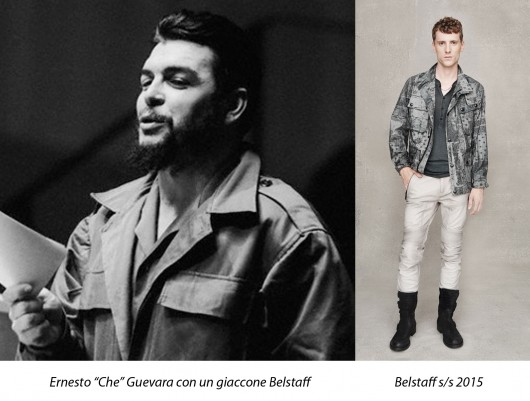 L’obiettivo, semplificando al massimo la questione, è quello di poter fare sport e starsene fuori casa anche con il brutto tempo. Da questa esigenza nasce, per esempio, il giaccone Belstaff, applicando uno strato di poliuretano al cotone e rendendo quest’ultimo impermeabile, così che dagli anni ’20 del secolo ventesimo, si può praticare il motociclismo infangandosi finché si vuole, rimanendo all’asciutto e proteggendosi dal vento.
L’obiettivo, semplificando al massimo la questione, è quello di poter fare sport e starsene fuori casa anche con il brutto tempo. Da questa esigenza nasce, per esempio, il giaccone Belstaff, applicando uno strato di poliuretano al cotone e rendendo quest’ultimo impermeabile, così che dagli anni ’20 del secolo ventesimo, si può praticare il motociclismo infangandosi finché si vuole, rimanendo all’asciutto e proteggendosi dal vento.  Esattamente per la stessa ragione raggiunge in breve un successo planetario il blouson conosciuto come G9 Baracuta, che unisce invece cotone e poliestere, immortalato da figure come Steve McQueen, James Dean, Paul Newman, tanto da divenire un simbolo del vestire libero e disinvolto. E poi, nella medesima scia, arrivano il k-way, il parka, l’eskimo…
Esattamente per la stessa ragione raggiunge in breve un successo planetario il blouson conosciuto come G9 Baracuta, che unisce invece cotone e poliestere, immortalato da figure come Steve McQueen, James Dean, Paul Newman, tanto da divenire un simbolo del vestire libero e disinvolto. E poi, nella medesima scia, arrivano il k-way, il parka, l’eskimo… 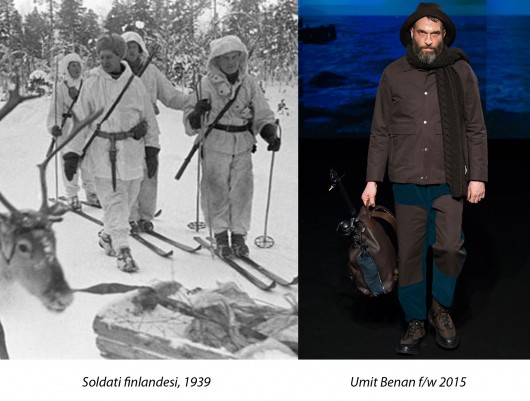 Purtroppo però, il ragionamento sulla natura sempre in progress della materia è legato anche ad occasioni meno felici e di certo meno nobili. E’ inutile nascondere che la guerra sia, tra queste occasioni, forse una delle più incisive. I Paesi più avanzati, come gli Stati Uniti, quelli in cui gli investimenti in fatto di armamenti hanno sempre costituito una voce di rilievo, come l’Unione Sovietica di Stalin, oppure quelli avvezzi a temperature proibitive, come la remota Finlandia, nel secolo passato hanno voluto o dovuto prestare grande attenzione all’ottimizzazione tecnologica dell’abbigliamento da combattimento.
Purtroppo però, il ragionamento sulla natura sempre in progress della materia è legato anche ad occasioni meno felici e di certo meno nobili. E’ inutile nascondere che la guerra sia, tra queste occasioni, forse una delle più incisive. I Paesi più avanzati, come gli Stati Uniti, quelli in cui gli investimenti in fatto di armamenti hanno sempre costituito una voce di rilievo, come l’Unione Sovietica di Stalin, oppure quelli avvezzi a temperature proibitive, come la remota Finlandia, nel secolo passato hanno voluto o dovuto prestare grande attenzione all’ottimizzazione tecnologica dell’abbigliamento da combattimento. 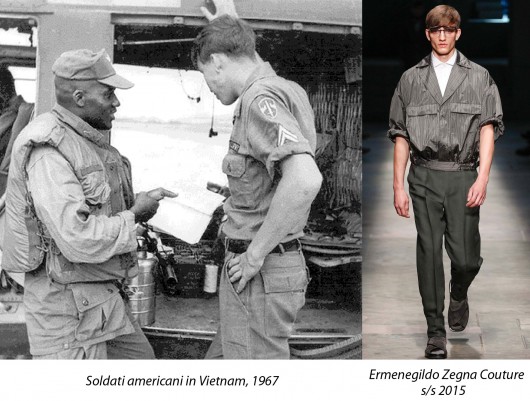 In questo contesto decollano, la messa a punto e l’utilizzo generalizzato del nylon. Sono di nylon imbottito le flak jacket, i giubbotti antiproiettile che la U.S. Army utilizza durante la Seconda Guerra Mondiale, in Corea, in Vietnam. E sono di un rudimentale materiale sintetico, anch’esso imbottito, le tute anti-gelo grazie alle quali, alle porte di Mosca, l’Armata Rossa ferma la Wehrmacht tedesca, meglio armata e soprattutto molto meglio organizzata.
In questo contesto decollano, la messa a punto e l’utilizzo generalizzato del nylon. Sono di nylon imbottito le flak jacket, i giubbotti antiproiettile che la U.S. Army utilizza durante la Seconda Guerra Mondiale, in Corea, in Vietnam. E sono di un rudimentale materiale sintetico, anch’esso imbottito, le tute anti-gelo grazie alle quali, alle porte di Mosca, l’Armata Rossa ferma la Wehrmacht tedesca, meglio armata e soprattutto molto meglio organizzata. 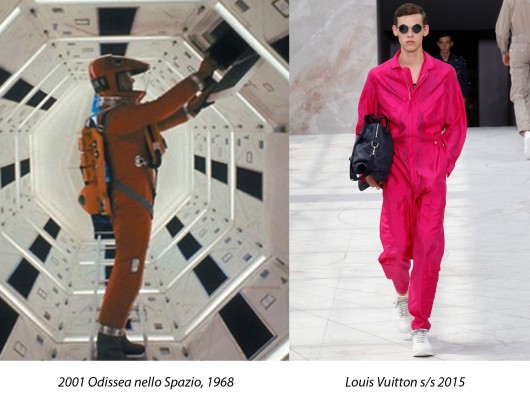 Sono del tutto simili le uniformi d’inverno del piccolo, ma tenacissimo, esercito finlandese che per ben due anni, tra il 1939 ed il 1941, tiene testa ai Sovietici, finendo per soccombere solo per clamorosa inferiorità numerica. Va detto però che nylon e consimili possono riscattare il loro iniziale impiego non proprio disinteressato negli sport: nell’alpinismo, nello ski, nell’automobilismo. Arrivando a tempi meno duri, si arriva anche all’uso, per così dire, fine a se stesso dei materiali “inventati”. Sono gli anni dello Sputnik, quando ci si immagina l’uomo del futuro vestito con tute di plastica e/o di metallo.
Sono del tutto simili le uniformi d’inverno del piccolo, ma tenacissimo, esercito finlandese che per ben due anni, tra il 1939 ed il 1941, tiene testa ai Sovietici, finendo per soccombere solo per clamorosa inferiorità numerica. Va detto però che nylon e consimili possono riscattare il loro iniziale impiego non proprio disinteressato negli sport: nell’alpinismo, nello ski, nell’automobilismo. Arrivando a tempi meno duri, si arriva anche all’uso, per così dire, fine a se stesso dei materiali “inventati”. Sono gli anni dello Sputnik, quando ci si immagina l’uomo del futuro vestito con tute di plastica e/o di metallo. 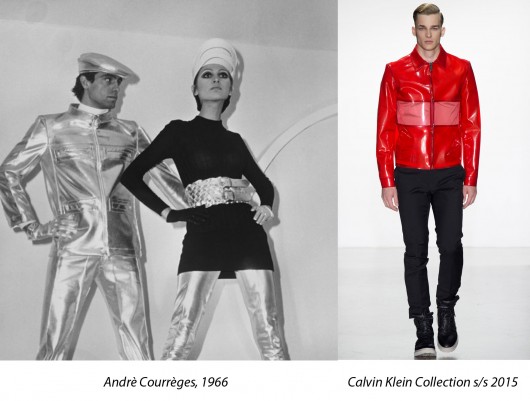 Sono gli anni della ridiscussione delle barriere tra maschile e femminile, della trasgressione, dell’immaginazione al potere, della rivoluzione di un ordine costituito borghese del ben vestire vecchio ormai di quasi duecento anni, preso a picconate, tra le altre, dalle esperienze di Courrèges e di Cardin. Una rivoluzione che, ci si augura, continui a dare i suoi frutti. Da assaggiare con il dovuto libero arbitrio di cui ognuno di noi, essere pensante, è dotato. Giorgio Re
Sono gli anni della ridiscussione delle barriere tra maschile e femminile, della trasgressione, dell’immaginazione al potere, della rivoluzione di un ordine costituito borghese del ben vestire vecchio ormai di quasi duecento anni, preso a picconate, tra le altre, dalle esperienze di Courrèges e di Cardin. Una rivoluzione che, ci si augura, continui a dare i suoi frutti. Da assaggiare con il dovuto libero arbitrio di cui ognuno di noi, essere pensante, è dotato. Giorgio Re
Plastic and co.: polyurethane, polyester, nylon, lycra, vinyl, sky…since the 50s, one of the great challenges of fashion has been the recourse to those materials invented or redesigned by technology. The material redesign, in less than a century, gathered a higher speed than in the centuries before. In a few decades fashion has had at its disposal an incredibly wider range of materials, with an immeasurable advantage for creativity and bringing a decisive mark on the way we think about clothing today. The process of material innovation applied on clothing starts from the need of functionality. A necessity often related to spare time, sport and outdoor activities. From a very innovative area in the technology field, the UK, a part of the world characterized by bad weather, came several garments, that became shortly legendary, made of industrially developed materials – sometimes coupled with natural fabrics. To oversimplify, the purpose was to be able to train and stay outside even with rain. One of these garments was the Belstaff coat, made of cotton with a layer of polyurethane that made it waterproof, so that, since the 20s, it was possible to do motorcycling getting covered in mud but staying dry and protected from wind at the same time. For the same reason, the Baracuta G9 blouson, made of cotton and polyester, had a great success all over the world and has been worn by Steve McQueen, James Dean, Paul Newman, becoming an icon of casual clothing. And then came the k-way, the parka, the eskimo…But unfortunately, this evolution of fabric is also related to war. The most advanced Countries, like the USA, those Countries that has always made great investments in artillery, like Stalin’s Sovietic Union, or those used to freezing cold, like the far Finland, in the last century payed much attention to technological optimization of combat clothing. In this context there was a spread of the use of nylon. The flak jackets, the bulletproof vests used by the U.S. Army during the Second World War, and then in Korea and Vietnam, were made of nylon. And the antifreeze tracksuits, worn by the Red Army during the battle against the german Wehrmacht, were made of a stuffed rudimentary synthetic fabric. But nylon had a great use in sport activities too: in mountaineering, skiing, car racing. In less hard times, there was a spread of the use of these new fabrics with an end in itself. These are the years of the Sputnik, of the “man of the future” who wears suits made of plastic and/or metal. These are the years of the redefinition of the blocks between masculine and feminine, of transgression, of imagination in power, of the revolution of the old, bourgeois concept of the elegant attire, demolished by, for example, the creations of Courrèges and Cardin. A revolution that, we hope, will keep on bearing fruits. Giorgio Re






